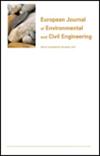One-dimensional piecewise-linear large-strain consolidation model for soft clay with anisotropic creep behaviour
IF 2.3
4区 工程技术
Q2 ENGINEERING, CIVIL
European Journal of Environmental and Civil Engineering
Pub Date : 2023-10-08
DOI:10.1080/19648189.2023.2264952
引用次数: 0
Abstract
AbstractViscous behaviour is a significant characteristic of soil, and to accurately capture this behaviour, a piecewise-linear model called ACLC has been developed specifically for modelling one-dimensional large-strain consolidation of soft clay. ACLC takes into account both the long-term deformation and anisotropy of the soil. Furthermore, it incorporates various factors such as soil heterogeneity, self-weight, time-dependent loading, vertical flows, and seepage force. In ACLC, the settlement of the soil layer is a result of both the net outflow of fluid from the soil element and the development of soil creep. To describe the creep behaviour of the soil, ACLC employs two yield surfaces: the Current State Surface (CSS) and the Normal Consolidation Surface (NCS). The creep rates are calculated based on the associated flow rule. To ensure the accuracy of ACLC, it is validated using the enhanced CS2 model, oedometer tests conducted on Xiaoshan soft clay, and observed data from the Murro test embankment. Finally, the influence of ACLC parameters on the consolidation behaviour of clay is thoroughly investigated. This analysis helps to understand the role of these parameters and their impact on the overall consolidation process.Keywords: Piecewise-linear modelconsolidationanisotropycreep Data availability statementSome or all data, models, or code that support the findings of this study are available from the corresponding author upon reasonable request.Disclosure statementNo potential conflict of interest was reported by the authors.Additional informationFundingThe research work in this paper was supported by the Basic Science Center Program for Multiphase Evolution in Hypergravity of the National Natural Science Foundation of China (grant number 51988101).具有各向异性蠕变特性的软粘土一维分段线性大应变固结模型
摘要粘性特性是土壤的一个重要特征,为了准确地捕捉这一特性,一种被称为ACLC的分段线性模型被开发出来,专门用于模拟软粘土的一维大应变固结。ACLC既考虑了土体的长期变形,又考虑了土体的各向异性。此外,它还考虑了各种因素,如土壤非均质性、自重、时变载荷、垂直流量和渗透力。在ACLC中,土层的沉降是土体单元流体净流出和土体蠕变发展的结果。为了描述土壤的蠕变行为,ACLC采用了两个屈服面:当前状态面(CSS)和正常固结面(NCS)。蠕变速率是根据相关的流动规则计算的。为保证ACLC的准确性,采用增强型CS2模型、萧山软土测深试验和Murro试验路堤观测数据对ACLC进行了验证。最后,深入研究了ACLC参数对粘土固结特性的影响。这种分析有助于理解这些参数的作用及其对整个巩固过程的影响。关键词:分段线性模型整合各向异性蠕变数据可用性声明支持本研究结果的部分或全部数据、模型或代码可根据合理要求从通讯作者处获得。披露声明作者未报告潜在的利益冲突。本文的研究工作得到国家自然科学基金超重力多相演化基础科学中心项目(批准号:51988101)的支持。
本文章由计算机程序翻译,如有差异,请以英文原文为准。
求助全文
约1分钟内获得全文
求助全文
来源期刊

European Journal of Environmental and Civil Engineering
ENGINEERING, CIVIL-ENGINEERING, GEOLOGICAL
CiteScore
4.80
自引率
4.80%
发文量
153
审稿时长
6 months
期刊介绍:
The European Research Area has now become a reality. The prime objective of the EJECE is to fully document advances in International scientific and technical research in the fields of sustainable construction and soil engineering. In particular regard to the latter, the environmental preservation of natural media (soils and rocks) and the mitigation of soil-related risks are now not only major societal challenges, but they are also the source of scientific and technical developments that could be extremely beneficial.
 求助内容:
求助内容: 应助结果提醒方式:
应助结果提醒方式:


